
Vintage Pistols Home >> Range Reports >> Smith & Wesson 4506 Range Report
Smith & Wesson Model 4506 - .45 ACP 3rd Generation Auto
The Smith and Wesson 4506 is a full-sized, stainless steel, 3rd generation DA/SA automatic chambered in .45 ACP. It was produced from 1988 to 1999, and was the replacement for the 2nd generation 645. Pictured is my 4506-1 that features a rounded trigger guard and three-dot sights. Earlier versions had a squared trigger guard. Adjustable sights were available as an option.
|
Click on a picture for a larger image |
||
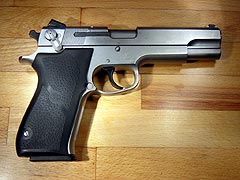 |
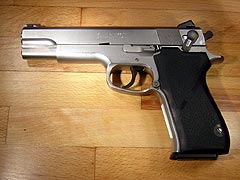 |
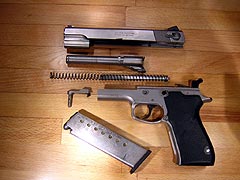 |
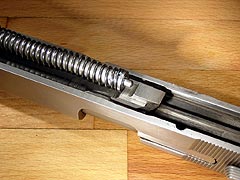 |
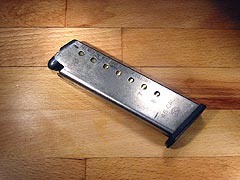 |
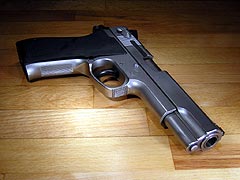 |
The 4506 is a "traditional" double-action, recoil operated,
locked-breech pistol, that uses a Browning High-Power type locking lug that is integral to the barrel.. It uses 8-round magazines
that are specific to it - the 4506 will not accept 1911 magazines (see pic 5).
It has a 5" barrel and a slide-mounted ambidextrous decocker/safety. Mine has aftermarket Hogue wrap-around grips.
The original polymer, one piece wrap-around grips are a little bit thinner, but they're hard and sort of slippery.
The Hogue grips add to the bulk, but who cares? Due to its enormous size and considerable weight, the 4506 is not a very
practical concealed carry gun. It is, however, a great house or range gun; and not that picky either.
This one has eagerly digested every sort of ammo that I could fit into the magazine. When I was learning
to reload .45 ACP; this pistol was my "garbage disposal".
Construction
The 4506 is a monster - it is so over-built that it's not even funny. The first impression you
get when you pick it up is, "Holy cow! This thing is big!" It's heavy too - weighing in at 3
pounds when loaded. The funny thing is, when you look at the specs, it's only slightly thicker
and slightly heavier than a full-size 1911. Let me tell you though; those small increases make a
world of difference. I've carried a full size stainless 1911 IWB and found it to be OK.
Try the same thing with a 4506 and it feels like you have en engine block in your pants. At the range, I
open-carry it in an old police retention holster. I use this rig to test any new gun belt. If the
4506 won't buckle it, I'm good to go.
I read somewhere that the reason for the 4506's extra bulk was that this pistol was based on the 10mm 1006 slide and frame design (which was itself over-built - even for a 10mm). I fire .45 ACP "+P" loads through it without a second thought. With a few special springs, the 4506 can even fire the potent .45 Super ®.
Like all 3rd generation S&W's, there's no removable barrel bushing on the slide. Instead, there's a rounded bulged area integral to, and at the end of the barrel (you can see this in pic 3 above). The diameter of this area is sized to precisely match the pressed-in bushing in the end of the slide. This provides for excellent accuracy while still maintaining a high degree of reliability, even when the pistol is dirty. Since the barrel bulge is radiused, there's a only very small bearing surface that contacts the slide, allowing any collected crud to be more easily displaced than in traditional arrangements.
Shooting it
When I first bought this, I took it home, cleaned it, stopped at Walmart for a Winchester White Box
of 230gr FMJ, and hit the range. The pistol functioned fine, except it was spraying the spent
cases in a wide arc about 30 feet from where I was standing. The slide also felt like it was
hammering back more than it should. Since these are classic signs of a weak recoil spring, I
ordered up a couple of replacements from Wolff Gunsprings.
The factory standard recoil spring weight for the 4506 is 14 Lbs. Wolff offers
recoil spring weights from 8 to 24 Lbs; so I picked up a 14 Lb factory replacement, as well as
a 16 Lb extra power spring in case I needed it for hotter loads (I haven't yet).
I installed the 14lb spring which was much harder to compress than the one that was in the pistol when I bought it. I don't know where the previous owner got a spring that weak, but I think that somewhere, a ballpoint pen is missing a spring. Back at the range firing the same WWB ammo, the slide hammering stopped, and the spent cases landed in a nice pile about 6 feet from where I was standing.
The double action trigger is very light and very smooth, if a bit long. It is very easy to like. However, the single action trigger is a different story. Like most DA/SA 3rd generation S&W autos, the single action trigger on the 4506 has about 3/8" of "crunchy" slack to take up if you release the trigger all the way. Some people never get used to this. It doesn't bother me because I don't release the trigger all the way all the way. It's got a fairly short (1/8") reset and a crisp break, and I release it only until it resets.
Reliability
I cannot for the life of me remember any time that this pistol has failed to feed a round or failed to eject a
spent case. As stated earlier, this pistol was my "garbage disposal" when I was learning to reload .45 ACP.
One time, I loaded several hundred 200 grain SWC lead bullets that were too short. I could barely get
through a magazine in any 1911 or Glock .45 without a failure to feed. The 4506 never ever had a problem with them.
It's too bad this thing is so big because it would make a great carry gun.
Accuracy
I don't know if it's the design, I don't know if I got a good one, or maybe it's the giant grips (I have big hands), but I
shoot this better than any of my 1911s. Most people that try it find it accurate as well. At 10 yards, it's not
unusual to find an 8-shot group in one ragged hole. I play a game with myself at the range. There's a 16" by 16"
steel gong 40 yards from the firing line. When I'm done shooting, before I can leave the range, I have to put an
entire magazine-full of rounds on the gong in less than 10 seconds. I can usually do this with the 4506 on the first mag
(even though I hate 3-dot sights). It seems to shoot everything well, but the most accurate load I've found for it is 230
grain poly-coated lead bullets in front of 5.5 grains of W231.
Field Stripping
Here's how you field strip a 4506:
- Remove the magazine and ensure that the pistol is unloaded.
- Cock the hammer and pull the slide back until the forward end of the slide release lever lines up with the notch cut into the bottom of the slide.
- Push on the exposed end of the slide release lever on the right side of the slide to pop it out, then withdraw the slide release lever from the left side of the slide.
- Remove the slide assembly by pulling it forward off the frame.
- Move the guide rod/recoil spring slightly forward, then lift it up from the recess in the barrel. CAUTION: This spring is under a lot of compression.
- Lift the back of the barrel and withdraw it backward and up out of the slide. The pistol is now field stripped.
The only tricky part about getting it back together is reassembling the guide rod and recoil spring back into the slide. The recoil spring is long (REALLY long - see pic 3 above) and powerful, and it can be quite difficult to hold the spring in its compressed state while trying to align the front tip of the guide rod with the hole in the front of the slide. I wish that S&W had used a captured spring/guide rod assembly like the one in the Glocks.
Another thing I've noticed on some 3rd Gen S&W autos (but not on this particular example) is that sometimes the edge of the guide rod that engages the recess in the barrel gets rounded over. This recess is quite shallow (see pic 4 above) and the edge of the guide rod in the tiny recess is all that holds that long and powerful recoil spring in place. If the guide rod gets rounded over, it can spontaneously disengage from the shallow slot in the barrel as soon as you pull the slide off the frame. When this happens, the guide rod is launched across the room by the recoil spring. This happened to me once when I was examining a 4006 at a gun shop. The shop owner looked at me like I was an idiot, but when we finally found the guide rod and he tried to put the pistol back together, he couldn't get the guide rod and spring to stay in place.
It's something to keep in mind when you pull the slide off because it could probably put your eye out.
Here's a cool image of a 4506 I found posted on the web:

The photo was taken just as the bullet was exiting the barrel! Note the puff of smoke coming out of the ejection port. Unlike mine, the one in the photo above has the adjustable sights.
In conclusion...
If you can find one of these in good shape for less than $500, buy it. I believe these pistols are under-rated and right now, under-valued.
Report by EddieCoyle - 12/18/2007